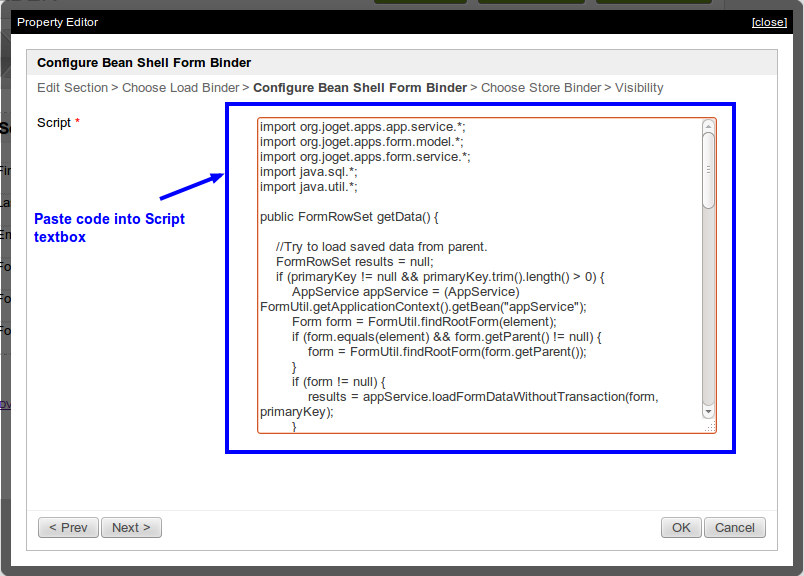You may initialize a new form with some fields prepopulated with the use of Beanshell Form Binder. Figure 1 shows an example of form that with the first 3 fields intended to be prepopulated.
Figure 1: Form with fields to prepopulate.
The quick and easy approach in addressing this requirement is to make use of the Beanshell Form Binder in the section's Load Binder. Edit the section.
Figure 2: Configure the section's properties to determine how data is being handled.
In the Load Binder, choose Bean Shell Form Binder as the Load Binder.
Figure 3: Choose Beanshell Form Binder as the Load Binder.
Configure the Bean Shell Form Binder with your own coding to populate the fields intended as shown in the next figure. This is the code used in this example.
import org.joget.apps.app.service.*;
import org.joget.apps.form.model.*;
import org.joget.apps.form.service.*;
import java.sql.*;
import java.util.*;
public FormRowSet getData() {
//-----------------------------------------------------------------------------------
//In this part of code, it trying to load the original data from form data table.
FormRowSet results = null;
if (primaryKey != null && primaryKey.trim().length() > 0) {
AppService appService = (AppService) FormUtil.getApplicationContext().getBean("appService");
Form form = FormUtil.findRootForm(element);
if (form.equals(element) && form.getParent() != null) {
form = FormUtil.findRootForm(form.getParent());
}
if (form != null) {
results = appService.loadFormDataWithoutTransaction(form, primaryKey);
}
}
//------------------------------------------------------------------------------------
//------------------------------------------------------------------------------------
//In this second part of code, it will load the data from external source by using
//JDBC. It will run only when the first part of code fail to retrieve data from
//form data table. This example use dir_user table of Joget as external source.
if (results == null) {
results = new FormRowSet();
Connection con = null;
try {
Class.forName("com.mysql.jdbc.Driver").newInstance();
con = DriverManager.getConnection("jdbc:mysql://localhost:3306/jwdb2?characterEncoding=UTF-8", "root", "root");
if(!con.isClosed()){
String pId = "#currentUser.username#";
String sql = "SELECT firstName, lastName, email FROM dir_user WHERE username=?";
PreparedStatement stmt = con.prepareStatement(sql);
stmt.setString(1, pId);
ResultSet rs = stmt.executeQuery();
while (rs.next()) {
FormRow row = new FormRow();
row.put("firstName", (rs.getString(1) != null)?rs.getString(1):"");
row.put("lastName", (rs.getString(2) != null)?rs.getString(2):"");
row.put("email", (rs.getString(3) != null)?rs.getString(3):"");
results.add(row);
}
}
} catch(Exception ex) {
System.err.println("Exception: " + ex.getMessage());
} finally {
try {
if(con != null)
con.close();
} catch(SQLException e) {}
}
}
//------------------------------------------------------------------------------------
return results;
}
return getData();
Figure 4: Populate the Beanshell Form Binder with the necessary codes.
With the coding properly written and tested. You should be able to achieve the result as shown in the next figure.
Figure 5: The 3 intended fields are prepolulated with values when a new form is loaded.




